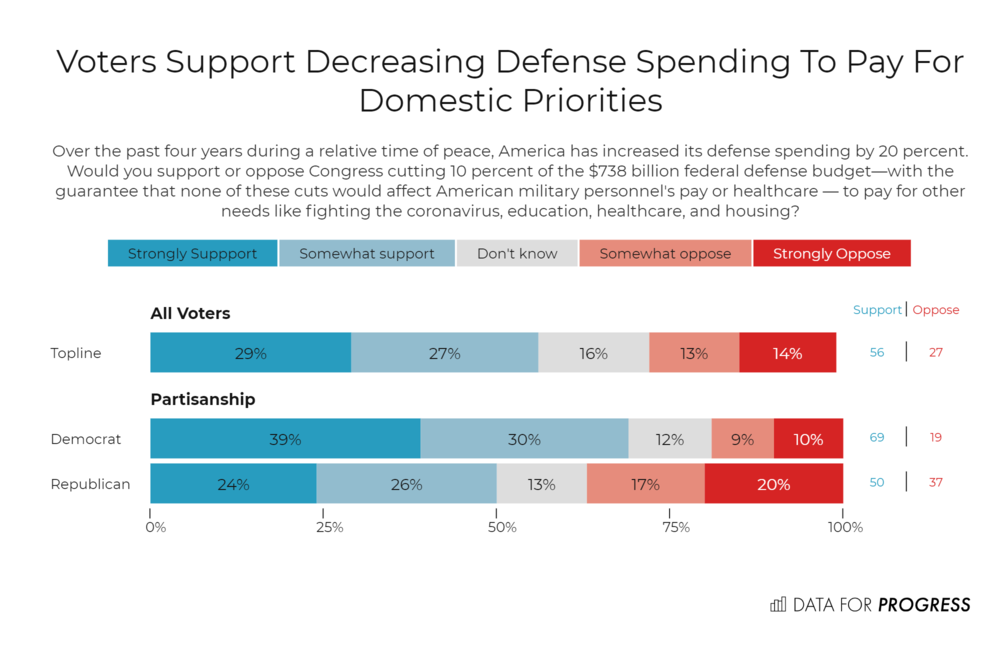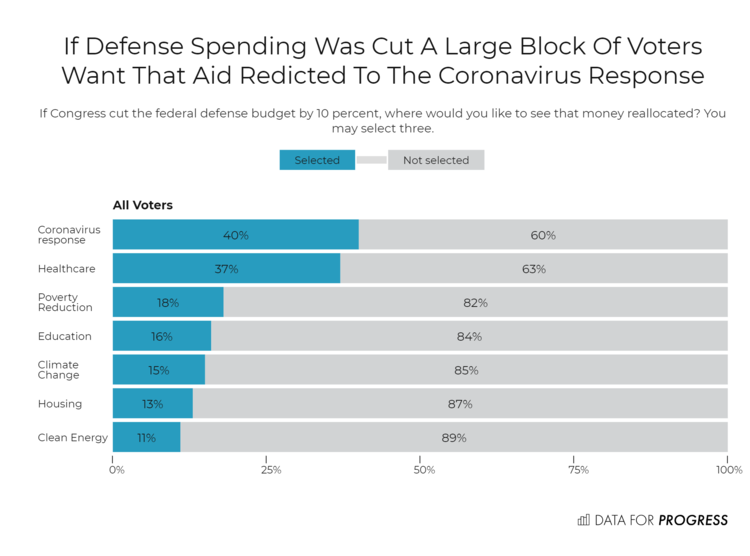Americans Want to Reinvest Ten Percent of the Military Budget Against Coronavirus
NPP Pressroom
Data for Progress
Ashik Siddique
07/21/2020
For years, boosting the military budget has been a bipartisan priority in Congress, with little accountability for how that money is spent. The same lawmakers in both parties often raise the specter of budget deficits to fear-monger against investments in urgent, popular priorities like heading off climate chaos through a Green New Deal, or expanding healthcare with Medicare for All.
That’s why, in 2020, the United States spends 53 percent of its discretionary budget on the military — more than the next 10 biggest spenders combined. The current military budget of $738 billion is higher than at any point since World War II, except at the height of the wars in Iraq and Afghanistan. That’s more than all federal spending on public health, education, housing, and renewable energy combined, while our society strains under the stresses of the ongoing coronavirus pandemic and growing economic crisis.
This week, progressives in the House and Senate are sticking a wedge in the works of the military-industrial budget process. Representatives Mark Pocan, Barbara Lee, and Pramila Jayapal, and Senators Bernie Sanders, Ed Markey, and Elizabeth Warren have introduced amendments to the annual National Defense Authorization Act (NDAA) that would reinvest 10 percent of the Pentagon budget in meeting critical human needs.
As it turns out, this is popular with a majority of voters across the political spectrum.
A new Data for Progress poll run from July 15 through July 16 found that 56 percent of likely voters support cutting the military budget by 10 percent to pay for priorities like fighting the coronavirus, education, healthcare, and housing. Only 27 percent were opposed.

That supportive majority includes half of Republicans, against 37 percent opposed to this reinvestment — a remarkable divergence from the Republicans elected to Congress, none of whom are on record as supporting this amendment as of this writing.
[...] Americans are ready to change course. Previous Data for Progress polling found support for a progressive overhaul of U.S. foreign policy, rejecting predominant fear-based framing in favor of a demilitarized agenda focused on international cooperation, human rights, and peace-building. Funding for diplomacy and foreign aid currently pales in comparison to the bloated military budget — redirecting any fraction of it would go a long way toward repairing the harmful legacy of US military interventions around the world.
War hawks often tout the military’s role as a job creator and poverty reducer, but at a time of widespread unemployment, it’s perverse that the Pentagon is effectively this country’s largest public jobs program. A study from Brown University found that, dollar for dollar, public investment in the military creates fewer jobs than spending in other sectors like education, health care, and clean energy.
Ten percent of the Pentagon budget would make a massive difference to any number of social priorities that currently receive fractions of the Pentagon’s federal funding.
When asked to choose three top priorities from among seven options for where they would like to see 10 percent of the military budget reallocated in the recent Data for Progress poll, 40 percent of voters chose coronavirus response, and 37 percent chose healthcare in general.

10 percent of the military budget would go a long way toward expanding the capacity of America’s healthcare system to contain and treat coronavirus. While many regions of the U.S. still lack coronavirus testing capacity amid a new surge of cases, $74 billion would be enough to offer six free tests to every one of the 330 million people in the country. Or it could buy enough N95 face masks for each one of the 55 million essential workers to use one a day for more than a year, or pay for the next 6 months of hospital stays for coronavirus patients at the high end of current national forecasts, an estimated 13,000 new hospitalizations per day.
[...] It’s worth putting this proposed 10 percent cut in context: the Pentagon budget was about 20 percent lower just four years ago during the Obama administration. Even larger reinvestments could make us all safer. Last year, the National Priorities Project and Poor People’s Campaign laid out a proposal to shave up to $350 billion off the military budget, a goal that Rep. Barbara Lee advanced last month with 19 cosponsors. That would bring spending down to about $400 billion per year, in keeping with Pentagon spending during much of the 1970s and 1990s — and still leave the U.S. with a clear advantage over any possible adversaries, with a bigger military budget than China, Russia, Iran, and North Korea combined.
Even before coronavirus, there was a strong case to redirect Pentagon resources. Now, as the greatest economic crisis of our lifetimes continues to intensify, should be a time for greater reckoning. As people across the country rise up to demand the defunding and demilitarization of police, coupled with reinvestments in communities that have been disproportionately harmed by racist state violence, extraction, and pollution, it’s past due for more Americans to ask whether a similar analogy shouldn’t be made for the US military’s role in the world.
Redirecting 10 percent of the Pentagon budget to fund healthcare, kickstart a Green New Deal jobs recovery, or reinforce public housing and education is a simple, sensible step in the right direction — away from metastasizing military expansion, and toward healing a society reeling from coronavirus.
The major challenges flaring up today are not ones with militarized solutions. They demand strong public investment in community well-being and resilient infrastructure.
Most people in the U.S. agree. This week, members of Congress should vote to follow their lead.